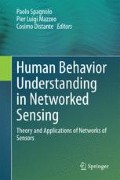Abstract
Counting the number of people traveling across nonoverlapping camera views generally requires every person who has exited a camera view to be reidentified when he/she reenters another camera view. A typical solution is to detect an individual person exiting or entering each camera view and establish their correspondence based on their visual appearances and the knowledge of the camera topology, transition time between cameras, etc. One of the main challenges is that the appearances of different people can be similar, while the appearance of the same person can vary in different camera views. On the other hand, a recent approach for counting people within a single camera view is “crowd-centric”, which is to extract foreground regions and estimate the crowd density of the regions. Considering that people often walk together with their acquaintances but not with strangers, the reidentification solution can be applied to the foreground regions to reidentify the groups of people. In this case, another problem arises, that is, people sometimes meet or part outside the field of views of the cameras. Thus, a foreground region can have correspondence with multiple foreground regions. Our proposed method handles both of these problems by estimating the flows from the foreground regions exiting the camera views to those entering other camera views based on the confidence levels of their correspondence and the constraints defined by the relationships among their areas. The estimated flows are then summed up to count the people traveling across each pair of cameras.
Access this chapter
Tax calculation will be finalised at checkout
Purchases are for personal use only
Notes
- 1.
Here, we assume that \(T\) is determined so that both the entry and exit of each person are captured in the time interval.
- 2.
Since no one entered the camera view he/she had exited in the videos used in the experiments, we did not consider such camera pairs, e.g., 1–1.
References
Bedagkar-Gala A, Shah SK (2014) A survey of approaches and trends in person re-identification. Image Vis Comput 32(4):270–286
Chan AB, Vasconcelos N (2012) Counting people with low-level features and bayesian regression. IEEE Trans Image Process 21(4):2160–2177
Chen T-H, Hsu C-W (2003) An automatic bi-directional passing-people counting method based on color image processing. In: IEEE international carnahan conference on security technology, pp 200–207
Dalal N, Triggs B (2005) Histograms of oriented gradients for human detection. In: IEEE conference on computer vision and pattern recognition, vol 1, pp 886–893
Dollar P, Wojek C, Schiele B, Perona P (2012) Pedestrian detection: an evaluation of the state of the art. IEEE Trans Pattern Anal Mach Intell 34(4):743–761
Gilbert A, Bowden R (2008) Incremental, scalable tracking of objects inter camera. Comput Vis Image Underst 111(1):43–58
Gray D, Brennan S, Tao H (2007) Evaluating appearance models for recognition, reacquisition, and tracking. In: IEEE international workshop on performance evaluation of tracking and surveillance
Javed O, Shafique K, Rasheed Z, Shah M (2008) Modeling inter-camera space-time and appearance relationships for tracking across non-overlapping views. Comput Vis Image Underst 109(2):146–162
Jacques S Jr, Musse SR, Jung CR (2010) Crowd analysis using computer vision techniques. IEEE Signal Process Mag 27(5):66–77
Kettnaker V, Zabih R (1999) Counting people from multiple cameras. In: IEEE international conference on multimedia computing and systems, vol 2, pp 267–271
Kilambi P, Ribnick E, Joshi AJ, Masoud O, Papanikolopoulos N (2008) Estimating pedestrian counts in groups. Comput Vis Image Underst 110(1):43–59
Kong D, Gray D, Tao H (2005) Counting pedestrians in crowds using viewpoint invariant training. In: British machine vision conference
Lian G, Lai J, Zheng W-S (2011) Spatial-temporal consistent labeling of tracked pedestrians across non-overlapping camera views. Pattern Recognit 44(5):1121–1136
Loy CC, Chen K, Gong S, Xiang T (2013) Crowd counting and profiling: methodology and evaluation. In: Modeling, simulation and visual analysis of crowds, Springer, New York, pp 347–382
Makris D, Ellis T, Black J (2004) Bridging the gaps between cameras. In: IEEE conference on computer vision and pattern recognition, vol 2, pp II-205–II-210
Nitta N, Nakazaki T, Nakamura K, Akai R, Babaguchi N (2013) People counting across spatially disjoint cameras by flow estimation between foreground regions. In: IEEE workshop on activity monitoring by multiple distributed sensing, pp 414–419
Paragios N, Ramesh V (2001) A mrf-based approach for real-time subway monitoring. In: IEEE conference on computer vision and pattern recognition, vol 1, pp I-1034–I-1040
Ryan D, Denman S, Fookes C, Sridharan S (2009) Crowd counting using multiple local features. In: Digital image computing: techniques and applications, pp 81–88
Sabzmeydani P, Mori G (2007) Detecting pedestrians by learning shapelet features. In: IEEE conference on computer vision and pattern recognition, pp 1–8
Tieu K, Dalley G, Grimson WEL (2005) Inference of non-overlapping camera network topology by measuring statistical dependence. In: IEEE international conference on computer vision, vol 2, pp 1842–1849
Vezzani R, Baltieri D, Cucchiara R (2013) People re-identification in surveillance and forensics: a survey. ACM Comput Surv 46(2):29:1–29:3
Wang X (2013) Intelligent multi-camera video surveillance: a review. Pattern Recogn Lett 34(1):3–19
Wang X, Han TX, Yan S (2009) An hog-lbp human detector with partial occlusion handling. In: IEEE international conference on computer vision, pp 32–39
Wu B, Nevatia R (2005) Detection of multiple, partially occluded humans in a single image by bayesian combination of edgelet part detectors. In: IEEE international conference on computer vision, vol 1, pp 90–97
Zhan B, Monekosso DN, Remagnino P, Velastin SA, Xu L-Q (2008) Crowd analysis: a survey. Mach Vis Appl 19(5–6):345–357
Author information
Authors and Affiliations
Corresponding author
Editor information
Editors and Affiliations
Rights and permissions
Copyright information
© 2014 Springer International Publishing Switzerland
About this chapter
Cite this chapter
Nitta, N., Akai, R., Babaguchi, N. (2014). People Counting Across Non-overlapping Camera Views by Flow Estimation Among Foreground Regions. In: Spagnolo, P., Mazzeo, P., Distante, C. (eds) Human Behavior Understanding in Networked Sensing. Springer, Cham. https://doi.org/10.1007/978-3-319-10807-0_11
Download citation
DOI: https://doi.org/10.1007/978-3-319-10807-0_11
Published:
Publisher Name: Springer, Cham
Print ISBN: 978-3-319-10806-3
Online ISBN: 978-3-319-10807-0
eBook Packages: Computer ScienceComputer Science (R0)

